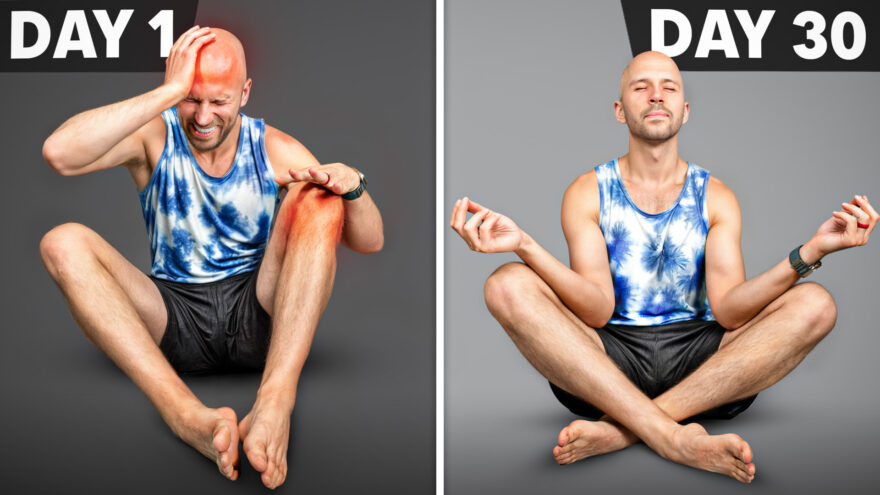Table of Contents
Reduce Tension for GOOD
Many people struggle with aches, pains, and mobility issues. These problems often worsen due to excess tension in our bodies—whether we’re moving or simply sitting or standing for long periods. To improve mobility and comfort, we need to learn how to move with less tension. This post will show you exactly how to do that.
Why Reducing Tension Matters
When muscles around our joints become too tight, they limit the space necessary for comfortable movement. This increased pressure can lead to discomfort and pain.
The key to enhancing your mobility lies in reducing tension and moving fluidly. Below, I’ll share a sequence of exercises that can help you achieve this goal.
Exercise Sequence
When doing the movements I’m about to show you, there are 3 keys to consider with each:
- Perform for 2-5 minutes: More time = less tension
- Nasal breathe only – harder to produce tenison with nasal breathing
- Move SLOW and NOT to end-range
Get it all right, and it won’t feel like much is happening. That’s a good thing, as if you aren’t feeling much, you aren’t producing tension.
1. Foam Roller Arm & Leg Roll
This exercise helps release tension by learning how to move slowly.
Steps:
- Lie on your side with a foam roller in front of you, resting your arm and leg on it.
- Slowly roll your body back and forth, keeping your head, chest, and torso aligned.
2. Block Decompression
This move enhances spinal and ribcage flexibility while reducing tension. People who are hella stiff have more front and backside muscle activity. This creates a squeezing force on the ribcage and pelvis. Compressing the sides of the body reduces this squeeze.
Steps:
- Use two yoga blocks: one along your ribcage and one at your pelvis.
- Lie on the blocks and rest your top hand across your chest, breathing deeply to melt into the blocks.
3. Clamshell Slide Roll
The next step is to improve external rotation (ER). The more ER you have, the more space you have. As when you externally rotate, your body takes up more space.
Steps:
- Lie on your side with arms extended in front, palms touching.
- Lift one knee and slide the top hand across your chest, rolling to the other side. Alternate sides.
4. Armbar Roll
This movement enhances internal rotation. You need this motion for any force producing activity.
Steps:
- Lie on your side with chest and pelvis parallel to the wall
- Top hand should hold a kettlebell, reaching it to the ceiling.
- Inhale and roll to your back. Your arm should be in the fist bump position.
- Exhale and roll back to the start position, reaching the weight toward the ceiling.
- Alternate sides
5. Hooklying Windshield Wipers
Now that you have external and internal rotation, we want to work on using both of these motions together.
Steps:
- Lie on your back with feet flat on the ground.
- Inhale and let one knee fall out to the side, then exhale while bringing the opposite knee towards the knee that fell out. Alternate sides.
Next Level Tension Reducing Exercises
All of the previous moves create a necessary foundation to fluid, low tension moving. Their only limitation is that they are ground-based. We need to also learn how to move with less tension in standing. These next moves will teach you exactly that.
1. Tai Chi Rotations
Here, you’ll be working on arm external and internal rotation in the standing position. You’ll also learn how to slowly shift your weight in standing.
Steps:
- Stand in an athletic stance with arms extended forward.
- Move one arm palm up to the side while the opposite arm goes palm down, shifting your weight side to side.
2. German Arm Swings
This exercise promotes dynamic movement and shoulder mobility.
Steps:
- Let your arms dangle at your sides and swing your trunk and arms side to side.
- Allow your hands to touch higher on your trunk as you gain momentum.
3. Retro Elephant Walks
This move emphasizes rhythm and fluid motion in the upper body. It’s a progression from the German arm swings, as you start in a greater amount of shoulder flexion.
Steps:
- Swing your arms and trunk in a fluid motion while standing.
- Allow your arms to move freely with your trunk’s motion.
Benefit: Enhances overall mobility and coordination.
4 &5. Leg Swings
This exercise improves dynamic hip mobility and leg strength.
Steps:
- Perform leg swings both forward and side-to-side, starting with short ranges.
- Gradually increase your speed and range as you improve.
Benefit: Promotes flexibility and strength in the hips and legs.
Sum Up
Reducing muscle tension is crucial for alleviating pain and enhancing movement. By practicing these exercises, you can unlock greater mobility and comfort in your daily life. Incorporate these exercises into your routine and feel the difference. Your body will thank you!

